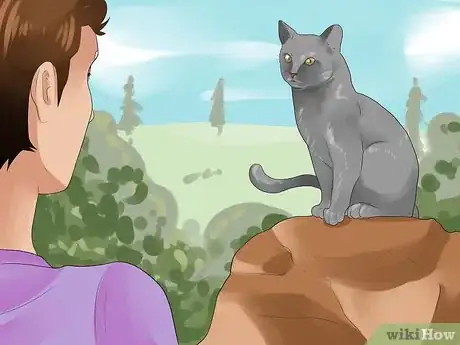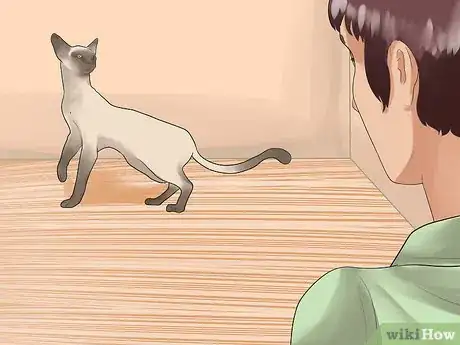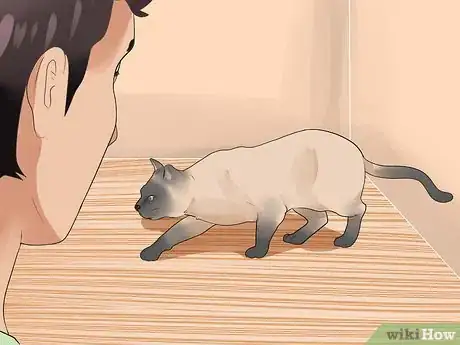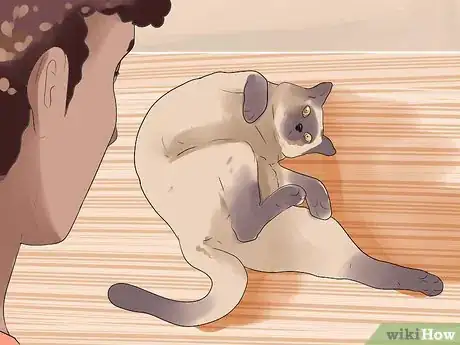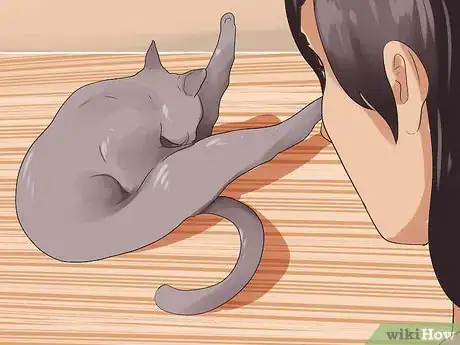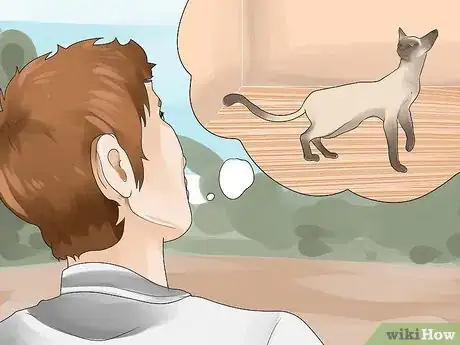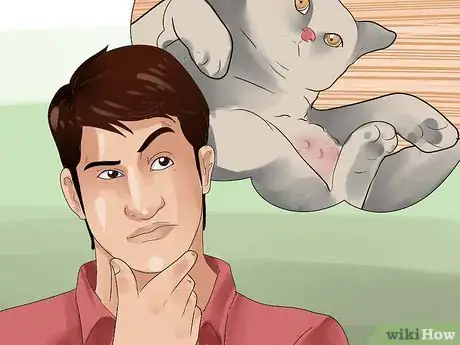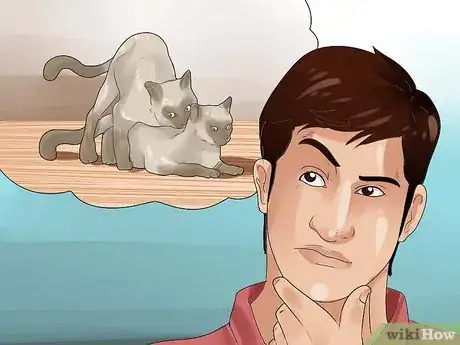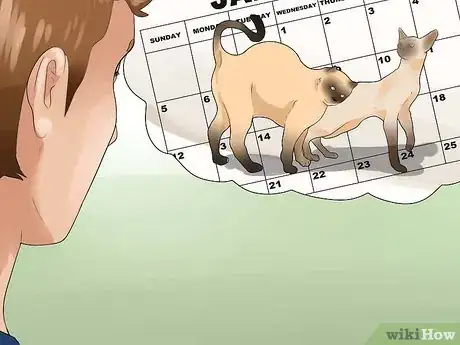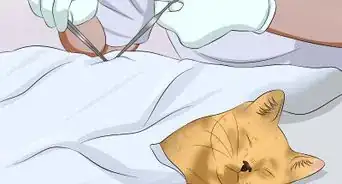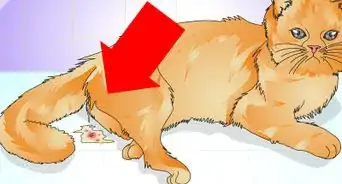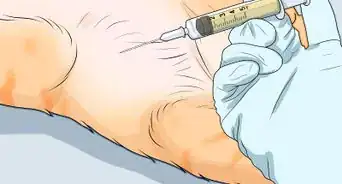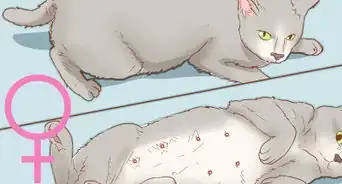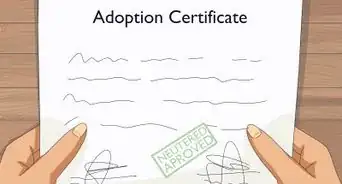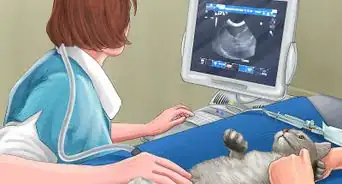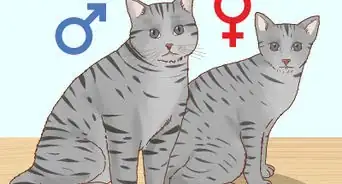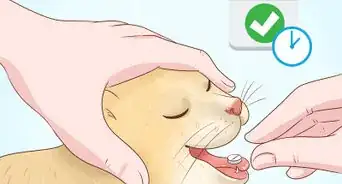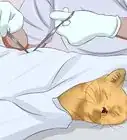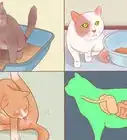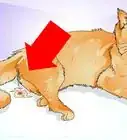This article was co-authored by Jean Johnson. Jean Johnson is a Cat Specialist and a writer for the KittyNook Blog. Jean specializes in providing advice on cat health, play, and general information about cats and cat breeds.
wikiHow marks an article as reader-approved once it receives enough positive feedback. This article received 33 testimonials and 85% of readers who voted found it helpful, earning it our reader-approved status.
This article has been viewed 1,432,993 times.
An unspayed female cat will become sexually mature between the ages 5 ½ and 12 months, depending on how well-fed she is and the day-length.[1] Unlike a feral cat that must compete for food and experiences the short days of winter, a house cat has the luxury of plenty of food and artificial light. This means that while feral cats have a breeding season, with kittens born in the spring and early autumn, your house cat can go into heat at any time, and will probably do so every three to four weeks. The behaviors of a cat in heat can be alarming if you can't recognize the cause, but these instructions will allow you to determine whether your cat is in heat.
Steps
Recognizing Behavioral Signs
-
1Listen for calling. Another term for being in heat is "calling." This is because the female becomes very vocal and will frequently walk around the house wailing or otherwise vocalizing.[2] This can sound like a plaintive, distressed cry, and can be loud and persistent enough to keep you awake at night.[3]
- If your cat is naturally chatty all the time, vocalization is not necessarily a sign she is in heat.
- When a cat is "calling," her cries typically becomes much louder and more persistent, and occur alongside other behaviors noted below.
-
2Watch for restless behavior. Restless behavior and an inability to settle are characteristic of a female cat in heat.[4] [5]
- This restlessness usually occurs at the same time as calling.
Advertisement -
3Expect increased affection. A female cat in heat is often much more affectionate than she would typically be.[6] If you cat is naturally stand-offish, this will usually change when she is in heat.[7]
- While in heat, your cat may rub around your ankles in such a persistent way that she becomes a trip hazard when you're trying to walk.
- This behavior will also manifest in the rubbing of her cheeks and chin (where her scent glands are located) against furniture, and especially entrance and exit points such as door frames.
- When in heat, a cat's scent changes subtly, and she enjoys spreading this around to advertise to that she'd like a mate to come visiting.[8]
-
4Pay attention to your cat's tail. A typical sign of a cat ready to mate is the tail deflection reflex. This simply means that when you rub her lower back, especially over her pelvis and tail base, the female sticks her bottom in the air and moves her tail to one side.[9]
- This reflex is her way of making it easier for a male cat to gain access to her vulva to mate.
-
5
-
6Watch for rolling. Some female cats in heat will roll around on the ground and wail at the same time.[12]
- Understandably, if you don't know this behavior is entirely normal, it can appear alarming, and is a common cause of a panicked phone call to the on-call vet. However, this is not a sign that your cat is in pain.
-
7Watch for excessive licking. When a cat is in heat, it is typical for her vulva to become swollen. This mild swelling is uncomfortable, and will likely lead your cat to spend a lot of time washing the area.[13] [14]
- This swelling is too slight for the casual observer to notice, so don't expect to see a physical difference.[15]
-
8Expect the cat to disappear. Even home-loving cats get adventurous when in heat. If a male cat doesn't come calling, then she is likely to go wandering for a day or so to seek one out for herself.[16]
- If your cat is not spayed and you don't want her to get pregnant, keep her indoors during her heat and lock the cat flap so that intruders can't get in.
Understanding Your Cat's Reproductive Cycle
-
1Understand the estrus cycle. Female cats are polyestrous, which means they go into heat many times a year. [17]
- This is in contrast to dogs, which experience a diestrus cycle, coming into heat only twice a year. [18]
- While in heat, your cat's womb will become swollen as its blood-supply increases in anticipation of a pregnancy. You will not be able to observe this, however, as there are no external signs of this process.[19]
-
2Understand the role of seasons. The breeding season of feral cats is between spring and late summer. This means kittens are born away from the harshest of the winter weather, when their chances of survival would be reduced.[20]
- Artificial light can fool a pet cat into thinking it is not winter. As such, if your cat spends much time indoors, the changing of seasons will have little or no effect on her reproductive cycle.[21]
- Expect a cat that lives indoors to come into heat all year around.
-
3Know the time frame. The reproductive cycle of a female cat is, on average, 21 days. Of these three weeks, expect her to spend as many as seven days in heat.[22]
Expert Q&A
-
QuestionIs it painful to the cat when she goes into heat?
 Pippa Elliott, MRCVSDr. Elliott, BVMS, MRCVS is a veterinarian with over 30 years of experience in veterinary surgery and companion animal practice. She graduated from the University of Glasgow in 1987 with a degree in veterinary medicine and surgery. She has worked at the same animal clinic in her hometown for over 20 years.
Pippa Elliott, MRCVSDr. Elliott, BVMS, MRCVS is a veterinarian with over 30 years of experience in veterinary surgery and companion animal practice. She graduated from the University of Glasgow in 1987 with a degree in veterinary medicine and surgery. She has worked at the same animal clinic in her hometown for over 20 years.
Veterinarian No. Cats sometimes roll around and yowl when they are in heat, but this behavior is meant to attract a mate. It is not a sign of pain.
No. Cats sometimes roll around and yowl when they are in heat, but this behavior is meant to attract a mate. It is not a sign of pain. -
QuestionDo they pee once they are in heat?
 Pippa Elliott, MRCVSDr. Elliott, BVMS, MRCVS is a veterinarian with over 30 years of experience in veterinary surgery and companion animal practice. She graduated from the University of Glasgow in 1987 with a degree in veterinary medicine and surgery. She has worked at the same animal clinic in her hometown for over 20 years.
Pippa Elliott, MRCVSDr. Elliott, BVMS, MRCVS is a veterinarian with over 30 years of experience in veterinary surgery and companion animal practice. She graduated from the University of Glasgow in 1987 with a degree in veterinary medicine and surgery. She has worked at the same animal clinic in her hometown for over 20 years.
Veterinarian This is a tricky question because a female cat in heat does produce hormones which she passes in her urine, so she does value her pee as a way of advertising she wants a boyfriend. This can show itself as urine marking in the house. However, the signs are pretty similar for a urinary tract infection, which needs attention from your vet. If your cat has developed strange toileting habits then it's safest to get her checked over.
This is a tricky question because a female cat in heat does produce hormones which she passes in her urine, so she does value her pee as a way of advertising she wants a boyfriend. This can show itself as urine marking in the house. However, the signs are pretty similar for a urinary tract infection, which needs attention from your vet. If your cat has developed strange toileting habits then it's safest to get her checked over. -
QuestionCan I spay my cat while she is in heat?
 Pippa Elliott, MRCVSDr. Elliott, BVMS, MRCVS is a veterinarian with over 30 years of experience in veterinary surgery and companion animal practice. She graduated from the University of Glasgow in 1987 with a degree in veterinary medicine and surgery. She has worked at the same animal clinic in her hometown for over 20 years.
Pippa Elliott, MRCVSDr. Elliott, BVMS, MRCVS is a veterinarian with over 30 years of experience in veterinary surgery and companion animal practice. She graduated from the University of Glasgow in 1987 with a degree in veterinary medicine and surgery. She has worked at the same animal clinic in her hometown for over 20 years.
Veterinarian Yes, although it can be more dangerous. Some vets do charge more for the surgery if the cat is in heat.
Yes, although it can be more dangerous. Some vets do charge more for the surgery if the cat is in heat.
Warnings
- It is not normal for a female cat to have a vaginal discharge during estrus, so if you notice either blood or a yellow-green discharge while your cat is in heat, contact your veterinarian immediately.[23]⧼thumbs_response⧽
References
- ↑ Reproduction in the Dog & Cat. Christiansen. Publisher: Bailliere Tindall.
- ↑ Reproduction in the Dog & Cat. Christiansen. Publisher: Bailliere Tindall.
- ↑ Jean Johnson. Cat Expert.
- ↑ Jean Johnson. Cat Expert.
- ↑ Reproduction in the Dog & Cat. Christiansen. Publisher: Bailliere Tindall.
- ↑ Jean Johnson. Cat Expert.
- ↑ Reproduction in the Dog & Cat. Christiansen. Publisher: Bailliere Tindall.
- ↑ Reproduction in the Dog & Cat. Christiansen. Publisher: Bailliere Tindall.
- ↑ Reproduction in the Dog & Cat. Christiansen. Publisher: Bailliere Tindall.
- ↑ Jean Johnson. Cat Expert.
- ↑ Reproduction in the Dog & Cat. Christiansen. Publisher: Bailliere Tindall.
- ↑ Reproduction in the Dog & Cat. Christiansen. Publisher: Bailliere Tindall.
- ↑ Jean Johnson. Cat Expert.
- ↑ Reproduction in the Dog & Cat. Christiansen. Publisher: Bailliere Tindall.
- ↑ Reproduction in the Dog & Cat. Christiansen. Publisher: Bailliere Tindall.
- ↑ Reproduction in the Dog & Cat. Christiansen. Publisher: Bailliere Tindall.
- ↑ Reproduction in the Dog & Cat. Christiansen. Publisher: Bailliere Tindall.
- ↑ Reproduction in the Dog & Cat. Christiansen. Publisher: Bailliere Tindall.
- ↑ Reproduction in the Dog & Cat. Christiansen. Publisher: Bailliere Tindall.
- ↑ Reproduction in the Dog & Cat. Christiansen. Publisher: Bailliere Tindall.
- ↑ Reproduction in the Dog & Cat. Christiansen. Publisher: Bailliere Tindall.
- ↑ Reproduction in the Dog & Cat. Christiansen. Publisher: Bailliere Tindall.
- ↑ Reproduction in the Dog & Cat. Christiansen. Publisher: Bailliere Tindall.
About This Article
To tell if your cat is in heat, pay attention to her behavior. Cats that are in heat generally “call” or vocalize loudly and persistently. Your cat might also become more affectionate than usual by rubbing against your ankles constantly. Look to see if she is rolling around or going into a crouched position with her front half on the ground and her rear in the air, which can also indicate she is in heat. If your cat is at least 6 months old and unspayed, expect her to be in heat for about 1 week every 21 days. To learn more about cat’s reproductive cycles, keep reading.
